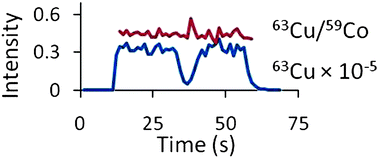Factors affecting internal standard selection for quantitative elemental bio-imaging of soft tissues by LA-ICP-MS†
Abstract
Element response variations under different laser ablation-inductively coupled plasma-

* Corresponding authors
a
Department of Chemistry and Forensic Science, University of Technology Sydney, Sydney, NSW, Australia
E-mail:
Philip.Doble@uts.edu.au
Fax: +61 2 9514 1460
Tel: +61 2 9514 1792
b Agilent Technologies Australia, North Ryde, NSW, Australia
c Department of Physics and Advanced Materials, University of Technology Sydney, Sydney, NSW, Australia
Element response variations under different laser ablation-inductively coupled plasma-

 Please wait while we load your content...
Something went wrong. Try again?
Please wait while we load your content...
Something went wrong. Try again?
C. Austin, F. Fryer, J. Lear, D. Bishop, D. Hare, T. Rawling, L. Kirkup, A. McDonagh and P. Doble, J. Anal. At. Spectrom., 2011, 26, 1494 DOI: 10.1039/C0JA00267D
To request permission to reproduce material from this article, please go to the Copyright Clearance Center request page.
If you are an author contributing to an RSC publication, you do not need to request permission provided correct acknowledgement is given.
If you are the author of this article, you do not need to request permission to reproduce figures and diagrams provided correct acknowledgement is given. If you want to reproduce the whole article in a third-party publication (excluding your thesis/dissertation for which permission is not required) please go to the Copyright Clearance Center request page.
Read more about how to correctly acknowledge RSC content.
 Fetching data from CrossRef.
Fetching data from CrossRef.
This may take some time to load.
Loading related content
